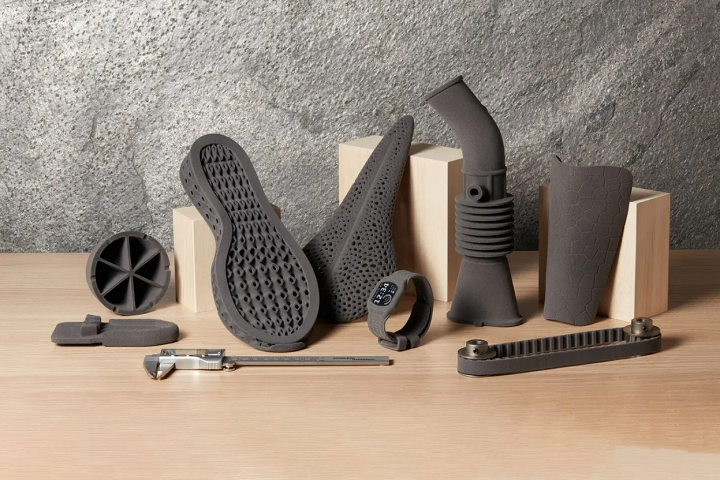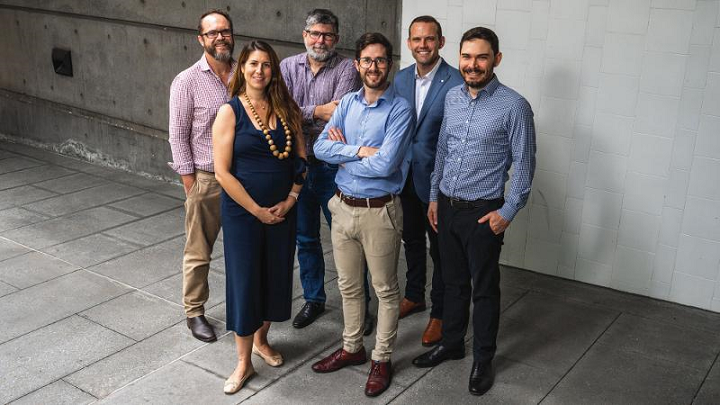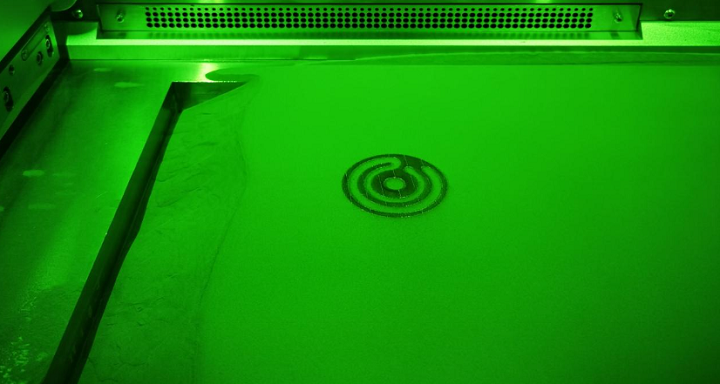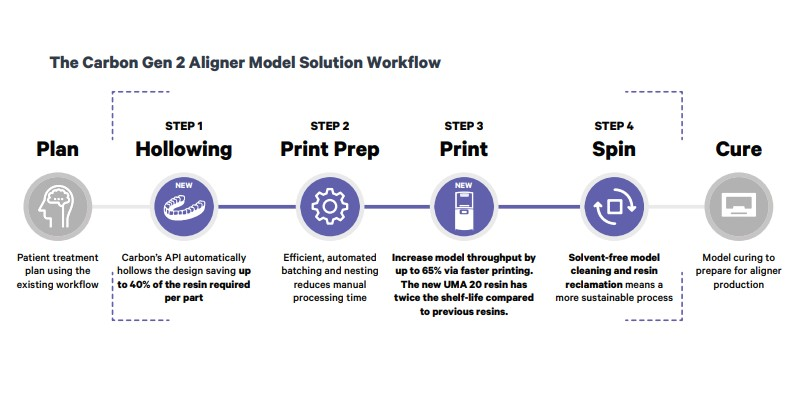Kicking off today’s 3D Printing News Briefs, Eplus3D released a new hybrid manufacturing solution. In materials news, Formlabs has introduced its first flexible SLS 3D printing material. Then it’s on to dental and medical applications, as Carbon announced a new production option for 3D printed clear aligners and QUT researchers are investigating 3D printing insoles for people in remote areas with diabetes-related foot disease. Finally, an international design studio has revealed its plan for a 3D printed, climate-responsive pavilion.
Eplus3D Introduces MPBF Hybrid Manufacturing Solution
Metal additive manufacturing solutions provider Eplus3d recently released its new MPBF Hybrid Manufacturing Solution, meant to improve hybrid manufacturing of metal 3D printing. The solution is used for automatic hybrid manufacturing, and features one-click positioning—the software collects images, and obtains the contour map, of the parts, then uses these to automatically calculate their position information. Users only need a basic understanding powder-based AM processes to use this new workflow, which enhances the accuracy and efficiency of the 3D printed parts, as well as improves metal AM competitiveness and lowers production costs.
The user will guide the software to recognize both the inner and outer contours of a part on the machine’s operating screen. Then, the software will automatically position the data with, as Eplus3D says, “a reposition accuracy of lower than 0.1mm.” The system uses the same camera as the one in the company’s active powder bed monitoring module, so it’s easy to integrate this solution for customers already using the monitoring function. The new MPBF Hybrid Manufacturing Solution successfully completed testing, and won acceptance from Eplus3D’s lead customers, and all customers are now eligible to upgrade their current systems with this Hybrid Module. The solution will likely be used in the automotive and tooling industries, especially for mold-making applications.
Formlabs Announces First Flexible SLS Material

TPU 90A Powder is ideal for prototyping functional prototypes for parts that require flexibility, like skin-safe wearables, performance sports equipment, or shoe insoles.
Formlabs has introduced its first soft-touch material for the Fuse Series SLS 3D printers: TPU 90A powder, a flexible elastomer with applications in protective sporting equipment, skin-safe wearables, manufacturing aids like gaskets, seals, and plugs, and medical devices like splints, orthotics, and prosthetics. The durable, rubbery material is great for printing fast, flexible, and geometrically advanced parts in-house, and features the company’s lowest refresh rate—20%—of all of its SLS powders, which helps reduce cost per part. Formlabs says with TPU 90A and its Fuse Series, it’s now possible to consistently 3D print soft-touch parts that were previously mass-produced for reliability. Users can easily integrate the powder into a Fuse Series and Fuse Sift workflow, as the material doesn’t require an inert atmosphere, and the depowdering process is fairly simple, as TPU parts don’t use Surface Armor. One customer that’s very happy with using TPU 90A for functional prototyping is Radio Flyer, the maker of the iconic Original Little Red Wagon®.
“The high-grip surface finish is unique compared to other 3D printed TPE/TPUs I’ve interacted with. From that standpoint, it does feel more similar to our injection molded TPE/TPU which is exciting from a prototype application. Currently, the next best alternative to this process would be a prototype tool and injecting actual TPE or other urethanes so this is both more cost and time effective,” said Radio Flyer’s development process, and design engineer Agostino Lobello.
“The parts themselves appear to be quite durable. We would have no issues installing them on works-like prototypes and sending them home for testing for ergonomic and usability feedback. We are excited about the prospect of using this material for tire treads, hand grips, bumpers, seat cushions, and as a way to prototype TPE springs with a specific spring-rate.”
Carbon’s Gen 2 Aligner Model 3D Printing Solution Boosts Efficiency
At the recent International Dental Show in Cologne, Carbon announced a new sustainable 3D printing solution for more efficient clear aligner model manufacturing. The Carbon Gen 2 aligner model solution is said to offer significant cost savings, as well as a 65% increase in throughput and less material per print. The solution integrates with the company’s current 3D printer hardware and aligner model workflow, and is made up of the Carbon L1 3D printer, new UMA 20 high-performance resin, solventless spin cleaning solution, and new proprietary API-based software that automates model hollowing, nesting, and batching. The new Carbon Gen 2 aligner model solution will be available to customers later this year.
“Working with the top clear aligner companies has given us insight into the barriers this industry faces on a daily basis. We heard from customers and we took action to create efficiencies and cost savings in the clear aligner workflow. This new aligner workflow is designed to enable Carbon customers reduce cost per part while simultaneously improving model throughput with a more sustainable production process,” said Terri Capriolo, Senior Vice President, Oral Health at Carbon.
QUT Researchers Receive Grant for 3D Printed Diabetic Insoles Project

Pictured from back left: QUT’s Associate Professor Peter Lazzarini, Professor Mia Woodruff, Dr Sean Powell, Dr Edmund Pickering, Associate Professor David Holmes, Alex Terrill
A team of researchers from Queensland University of Technology (QUT) has been working on a project to 3D print personalized, low-cost, pressure-offloading insoles for people in remote areas living with diabetes-related foot disease. People in remote or regional areas can have less access to podiatry services, which leads to reduced chances of their diabetes-related foot ulcers healing; ultimately, this contributes to a higher risk of amputation. The project, “3D digital solutions for diabetes-related foot ulcer offload treatment,” recently received a $810,000 Medical Research Future Fund Primary Health Care Digital Innovations Grant to help with their work. The industry partner is Aptium3D, while other members of the research team include Professor Jonathan Golledge from James Cook University and Dr Kerrie Evans from the University of Sydney, as well as associate investigators Dean Hartley, Chief Technology Officer, Healthia Ltd, and Scott Morrison, General Manager, iOrthotics, Greater Brisbane.
“Our research team will develop and evaluate low-cost foot scanning technologies, developed in partnership with Aptium3D within an established digital framework,” said Professor Mia Woodruff, from the QUT Centre for Biomedical Technologies.
“These technologies will be integrated in the allied healthcare organisation, Healthia’s, diabetes-related foot ulcer (DFU) monitoring, diagnosis and treatment pipeline for use in regional communities.
“Our innovative 3D dynamic foot scanner will be used by expert podiatrists as a telehealth device for remote monitoring and diagnosis.
“It will be coupled with advanced, flexible, metamaterial 3D-printing technologies to create personalised insoles to help protect the feet from injury and ulceration.”
3D Printed Climate-Responsive Public Pavilion
As we deal with the global crisis of plastic waste, international design studio Hassell is working with to.org and Nagami, a 3D printing design studio, to develop a public pavilion 3D printed from recycled plastic, which could be quickly adapted to fit a variety of environments. Inspired by indigenous shelters and meant to serve as a gathering place for education and meditation, this proof of concept pavilion was created using computational approaches, can run off the grid with minimum energy, and is entirely 3D printed, which makes it less expensive to adapt the shelter. The main structure will be printed in 24 separate pieces, so it can be easily transported and assembled onsite, and is climate-sensitive; for instance, it will be hermetically closed in the cold, with fins on its outer skin designed to capture snow for natural insulation. During hotter climates, overlapping fins will allow for cross ventilation, passive cooling, and water harvesting.
“We have more than 5 billion metric tons of plastic waste on our planet. As 3D printing scales up into the domain of architecture and construction, we can massively increase the demand for recycled plastics, and therefore speed up the cleaning process of our oceans and landfills,” said Manuel Jimenez Garcia, Founder of Nagami. “We hope this project will contribute to inspiring a new generation of architects to truly believe that a radical change in construction, driven by eco-innovation, is truly possible.”
Subscribe to Our Email Newsletter
Stay up-to-date on all the latest news from the 3D printing industry and receive information and offers from third party vendors.
You May Also Like
Gorilla Sports GE’s First 3D Printed Titanium Cast
How do you help a gorilla with a broken arm? Sounds like the start of a bad joke a zookeeper might tell, but it’s an actual dilemma recently faced by...
Nylon 3D Printed Parts Made More Functional with Coatings & Colors
Parts 3D printed from polyamide (PA, Nylon) 12 using powder bed fusion (PBF) are a mainstay in the additive manufacturing (AM) industry. While post-finishing processes have improved the porosity of...
$25M to Back Sintavia’s Largest Expansion of Metal 3D Printing Capacity Since 2019
Sintavia, the digital manufacturing company specializing in mission-critical parts for strategic sectors, announced a $25 million investment to increase its production capacity, the largest expansion to its operations since 2019....
Velo3D Initiates Public Offering in a Bid to Strengthen Financial Foundations and Drive Future Growth
Velo3D (NYSE: VLD) has been among a number of publicly traded 3D printing firms that have attempted to weather the current macroeconomic climate. After posting a challenging financial report for 2023,...


































